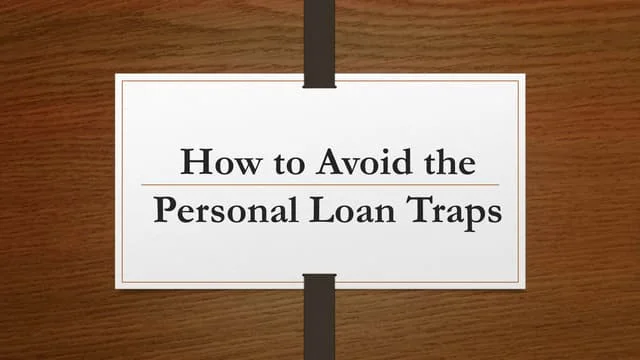Personal loans can be a powerful tool when used correctly. They offer quick access to funds, fixed repayment terms, and can help with everything from consolidating debt to covering emergencies or financing major purchases. However, not all personal loans are created equal, and not all borrowers use them wisely. Without proper knowledge and caution, a personal loan can easily turn into a financial burden instead of a solution.
In this article, we explore the most common personal loan traps to avoid, so you can borrow smart and stay financially secure.
1. Ignoring the Total Cost of the Loan
Many borrowers focus solely on the monthly payment amount and overlook the total cost of the loan over time. This is a major mistake.
Why It’s a Trap:
- A low monthly payment may seem manageable, but if it’s stretched over several years, you could end up paying thousands more in interest.
- Some lenders quote attractive rates but add hidden fees or penalties that increase the true cost.
How to Avoid It:
- Always compare the APR (Annual Percentage Rate)—not just the interest rate.
- Use loan calculators to see the total repayment amount before signing.
- Ask the lender for a full amortization schedule.
2. Falling for Extremely Low Introductory Rates
Some lenders promote teaser rates—very low or even 0% interest for a short period. While this sounds tempting, the rate often skyrockets after the introductory period ends.
Why It’s a Trap:
- If you can’t pay off the loan during the promo period, you’re hit with high-interest rates, sometimes even retroactive charges.
- The terms and conditions may be hidden in the fine print.
How to Avoid It:
- Read all the loan terms carefully, especially regarding rate changes.
- Choose fixed-rate personal loans whenever possible to ensure stability.
3. Overborrowing Beyond Your Needs
Just because you qualify for a larger loan doesn’t mean you should take it. Many borrowers fall into the trap of borrowing more than they actually need, which increases the interest paid and the temptation to spend unnecessarily.
Why It’s a Trap:
- You pay more interest over the life of the loan.
- It can lead to overspending and worsen financial habits.
How to Avoid It:
- Borrow only the amount you need and can reasonably repay.
- Create a detailed budget and stick to it before deciding on a loan amount.
4. Ignoring Your Credit Score
Your credit score determines your eligibility and the interest rate you’ll be offered. Taking out a personal loan without checking your credit first can lead to higher-than-necessary interest rates or even denial.
Why It’s a Trap:
- You may end up paying more than you should just because you didn’t shop around or take steps to improve your credit beforehand.
How to Avoid It:
- Check your credit score before applying.
- Prequalify with multiple lenders to compare your options without hurting your score.
- Work on improving your credit if your score is low.
5. Overlooking Fees and Penalties
Many personal loans come with origination fees, late fees, prepayment penalties, and other charges. These hidden costs can significantly increase your loan’s overall expense.
Why It’s a Trap:
- You may think you’re getting a good deal based on the rate alone, but the fees can eat away at the benefit.
- Prepayment penalties discourage early payoff, even if you can afford it.
How to Avoid It:
- Ask the lender to disclose all fees upfront.
- Read the fine print carefully and compare total costs—not just rates.
- Look for lenders that offer no-fee or low-fee loans.
6. Using a Loan to Pay Off Other Loans Repeatedly
It may feel like you’re solving the problem by consolidating or refinancing with a new personal loan, but repeatedly borrowing to pay off previous loans can lead to a debt cycle.
Why It’s a Trap:
- You’re not addressing the root issue—overspending or poor budgeting.
- It builds long-term dependence on credit.
How to Avoid It:
- Use personal loans as a one-time solution, not a recurring habit.
- Develop a long-term financial plan, including a budget and emergency fund.
- Consider working with a financial advisor or credit counselor.
7. Relying on Payday Loans or Predatory Lenders
Some lenders prey on financially vulnerable individuals, offering high-interest, short-term loans that are incredibly difficult to repay. These payday-style loans often come with triple-digit APRs, trapping borrowers in a vicious cycle of debt.
Why It’s a Trap:
- Massive fees and interest make it almost impossible to pay off in full.
- These loans are rarely reported to credit bureaus, offering no credit-building benefit.
How to Avoid It:
- Always verify the lender is reputable and licensed.
- Avoid loans with APRs above 36%.
- Stick with regulated banks, credit unions, or trusted online lenders.
8. Not Having a Repayment Plan
A loan is not free money—it must be paid back on time and in full. Borrowing without a clear repayment strategy leads to missed payments, penalties, and potential damage to your credit.
Why It’s a Trap:
- Missed payments lead to late fees and interest rate hikes.
- Delinquent accounts are reported to credit bureaus, hurting your score.
How to Avoid It:
- Budget for the loan payment before borrowing.
- Set up automatic payments or calendar reminders.
- Always have a backup plan (like an emergency fund) in case your income is disrupted.
Conclusion: Stay Smart and Stay Safe
While personal loans offer a practical solution for a range of financial needs, it’s essential to approach them with caution and a full understanding of the terms. Avoiding these personal loan traps can save you thousands of dollars and protect your long-term financial health.
Always take the time to compare options, read the fine print, and plan your repayment before accepting any loan. When used responsibly, a personal loan can be a helpful tool—not a financial trap.
